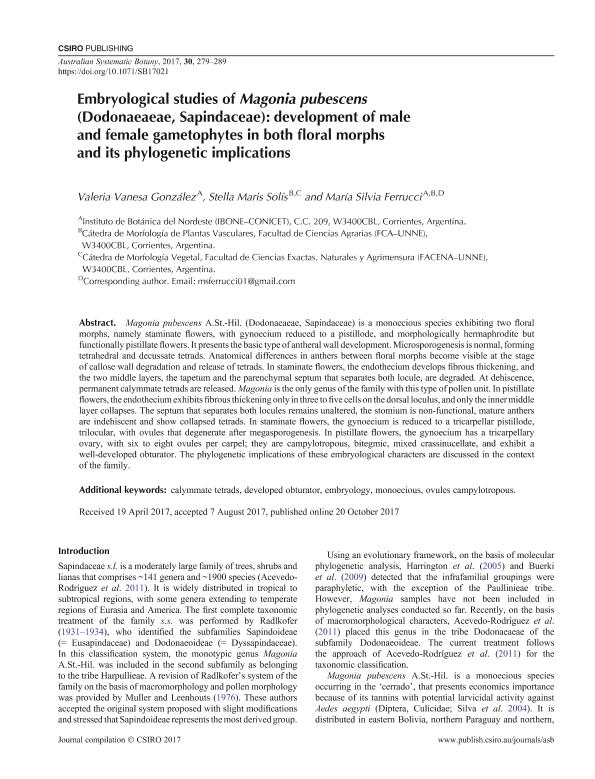Mostrar el registro sencillo del ítem
dc.contributor.author
González, Valeria Vanesa

dc.contributor.author
Solis, Stella Maris

dc.contributor.author
Ferrucci, María Silvia

dc.date.available
2018-04-05T21:03:51Z
dc.date.issued
2017-10
dc.identifier.citation
González, Valeria Vanesa; Solis, Stella Maris; Ferrucci, María Silvia; Embryological studies of Magonia pubescens (Dodonaeaeae, Sapindaceae): development of male and female gametophytes in both floral morphs and its phylogenetic implications; Csiro Publishing; Australian Systematic Botany; 30; 3; 10-2017; 279-289
dc.identifier.issn
1030-1887
dc.identifier.uri
http://hdl.handle.net/11336/41018
dc.description.abstract
Magonia pubescens A.St.-Hil. (Dodonaeaeae, Sapindaceae) is a monoecious species exhibiting two floral morphs, namely staminate flowers, with gynoecium reduced to a pistillode, and morphologically hermaphrodite but functionally pistillate flowers. It presents the basic type of antheral wall development. Microsporogenesis is normal, forming tetrahedral and decussate tetrads. Anatomical differences in anthers between floral morphs become visible at the stage of callose wall degradation and release of tetrads. In staminate flowers, the endothecium develops fibrous thickening, and the two middle layers, the tapetum and the parenchymal septum that separates both locule, are degraded. At dehiscence, permanent calymmate tetrads are released. Magonia is the only genus of the family with this type of pollen unit. In pistillate flowers, the endothecium exhibits fibrous thickening only in three to five cells on the dorsal loculus, and only the inner middle layer collapses. The septum that separates both locules remains unaltered, the stomium is non-functional, mature anthers are indehiscent and show collapsed tetrads. In staminate flowers, the gynoecium is reduced to a tricarpellar pistillode, trilocular, with ovules that degenerate after megasporogenesis. In pistillate flowers, the gynoecium has a tricarpellary ovary, with six to eight ovules per carpel; they are campylotropous, bitegmic, mixed crassinucellate, and exhibit a well-developed obturator. The phylogenetic implications of these embryological characters are discussed in the context of the family.
dc.format
application/pdf
dc.language.iso
eng
dc.publisher
Csiro Publishing

dc.rights
info:eu-repo/semantics/openAccess
dc.rights.uri
https://creativecommons.org/licenses/by-nc-sa/2.5/ar/
dc.subject
Calymmate Tetrads
dc.subject
Developed Obturator
dc.subject
Embryology
dc.subject
Monoecious
dc.subject.classification
Otras Ciencias Biológicas

dc.subject.classification
Ciencias Biológicas

dc.subject.classification
CIENCIAS NATURALES Y EXACTAS

dc.title
Embryological studies of Magonia pubescens (Dodonaeaeae, Sapindaceae): development of male and female gametophytes in both floral morphs and its phylogenetic implications
dc.type
info:eu-repo/semantics/article
dc.type
info:ar-repo/semantics/artículo
dc.type
info:eu-repo/semantics/publishedVersion
dc.date.updated
2018-03-21T15:30:59Z
dc.identifier.eissn
1446-5701
dc.journal.volume
30
dc.journal.number
3
dc.journal.pagination
279-289
dc.journal.pais
Australia

dc.journal.ciudad
Collingwood
dc.description.fil
Fil: González, Valeria Vanesa. Consejo Nacional de Investigaciones Científicas y Técnicas. Centro Científico Tecnológico Conicet - Nordeste. Instituto de Botánica del Nordeste. Universidad Nacional del Nordeste. Facultad de Ciencias Agrarias. Instituto de Botánica del Nordeste; Argentina
dc.description.fil
Fil: Solis, Stella Maris. Universidad Nacional del Nordeste. Facultad de Ciencias Exactas y Naturales y Agrimensura; Argentina
dc.description.fil
Fil: Ferrucci, María Silvia. Consejo Nacional de Investigaciones Científicas y Técnicas. Centro Científico Tecnológico Conicet - Nordeste. Instituto de Botánica del Nordeste. Universidad Nacional del Nordeste. Facultad de Ciencias Agrarias. Instituto de Botánica del Nordeste; Argentina
dc.journal.title
Australian Systematic Botany

dc.relation.alternativeid
info:eu-repo/semantics/altIdentifier/doi/http://doi.org/10.1071/SB17021
dc.relation.alternativeid
info:eu-repo/semantics/altIdentifier/url/http://www.publish.csiro.au/sb/SB17021
Archivos asociados
